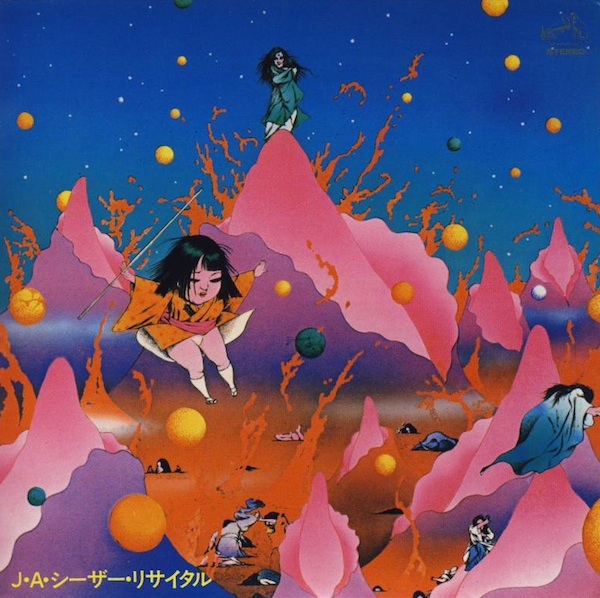
Exposé Online
What's old
Exposé print issues (1993-2011)
- 1 (October 1993)
- 2 (February 1994)
- 3 (May 1994)
- 4 (August 1994)
- 5 (October 1994)
- 6 (March 1995)
- 7 (July 1995)
- 8 (November 1995)
- 9 (March 1996)
- 10 (August 1996)
- 11 (February 1997)
- 12 (May 1997)
- 13 (October 1997)
- 14 (February 1998)
- 15 (July 1998)
- 16 (January 1999)
- 17 (April 1999)
- 18 (November 1999)
- 19 (May 2000)
- 20 (October 2000)
- 21 (March 2001)
- 22 (July 2001)
- 23 (December 2001)
- 24 (April 2002)
- 25 (September 2002)
- 26 (February 2003)
- 27 (August 2003)
- 28 (December 2003)
- 29 (April 2004)
- 30 (September 2004)
- 31 (March 2005)
- 32 (September 2005)
- 33 (May 2006)
- 34 (March 2007)
- 35 (January 2008)
- 36 (October 2008)
- 37 (July 2009)
- 38 (July 2010)
- 39 (Summer 2011)
Reviews
J.A. Caesar — Kokkyou Junreika
(Belle Antique 061216, 1972/2006, CD)
Tenjo Sajiki / J.A. Caesar — Shintokomaru
(Belle Antique 061217, 1978/2006, CD)
by Peter Thelen, Published 1996-08-01


J.A. Caesar — this is obviously not his real name — has been an enigmatic figure in Japanese rock and avant-garde music dating back to the early 70s. His music is impossible to categorize, each record being a radical departure from the previous, and up until earlier this year his records were impossible to find. These two albums, just reissued by Belle Antique, are very different from each other.
Kokkyou Junreika is clearly a product of the early 70s, the flavor is hard prog-rock mixed with psych, sort of a crude late-60s sort of production, and very unusual vocals. Since no credits are given in English, I can't be sure, but it sounds like we have a basic four-piece of guitar, bass, drums, and organ, with added percussion, along with a number of vocalists (lead male plus two or more female backing). The psychedelic rock basics are combined with a certain amount of role-playing on the part of the vocalists — a combination of near-operatic singing and spoken / shouted parts. The overall effect is powerful, albeit a little unrefined on the production side.
Eight years later, Shintokumaru exhibits far more refinement; that raw underground rock style has given way to a far more serious and theatrical style — in fact one is led to believe (based on booklet photos and overall feel of the music and dialog) that this is the musical score for a theatrical production of some type. Instrumentation involves some traditional Japanese instruments (biwa, shamisen, etc.) as well as rock instruments, and in general is very sparse, sometimes reminding of the first couple albums by Osamu Kitajima. Still a lot of spoken and operatic parts, hooting, shouting, and regular outbursts of great driving rock with searing guitar and violin. The heavy arpeggiated choral parts might even remind the listener of Magma at times. This is certainly an interesting listen, yet unless the listener is Japanese-fluent, one doesn't have a clue as to what's going on. Indeed this is one time when some information in the booklet, in English would have been helpful; still, it's great to finally be able to hear these obscure early Japanese artifacts.
Filed under: Reissues, Issue 10, 2006 releases, 1972 recordings, 1978 recordings
Related artist(s): Terahara Takaaki (J.A. Seazer / J.A. Caeser)
What's new
These are the most recent changes made to artists, releases, and articles.
- Review: Robert Schroeder - D.MO Vol. 5
Published 2024-04-26 - Release: Sam Wilson - Wintertides
Updated 2024-04-25 23:18:32 - Release: Sam Wilson - Groundless Apprehensions
Updated 2024-04-25 23:10:19 - Artist: Sam Wilson
Updated 2024-04-25 23:06:01 - Release: Ruins - Past... Present... Tense
Updated 2024-04-25 12:29:55 - Release: Ruins - The Art Dance
Updated 2024-04-25 12:19:41 - Release: Ruins - Brain Flakes (The Lost Combo Recordings)
Updated 2024-04-25 12:16:57 - Release: Ruins - New Record
Updated 2024-04-25 12:12:42 - Release: Ruins - Ruins
Updated 2024-04-25 12:11:44 - Release: Ruins - Marea / Tide
Updated 2024-04-25 12:10:48 - Artist: Ruins
Updated 2024-04-25 11:57:42 - Review: The Spacelords - Nectar of the Gods
Published 2024-04-25 - Release: 8x8 - New Data New Day
Updated 2024-04-24 12:13:42 - Review: Aglaia - Inner Enchantments
Published 2024-04-24 - Release: 8x8 - Life During Wartime
Updated 2024-04-23 17:55:39 - Review: Cheer-Accident - Vacate
Published 2024-04-23 - Release: s475e - Next Stop Earth
Updated 2024-04-22 16:06:30 - Artist: s475e (Darius Speier)
Updated 2024-04-22 16:05:44 - Release: Jim Black & the Shrimps - Ain't No Saint
Updated 2024-04-22 15:59:58 - Release: Jim Black Trio - Reckon
Updated 2024-04-22 15:58:55
